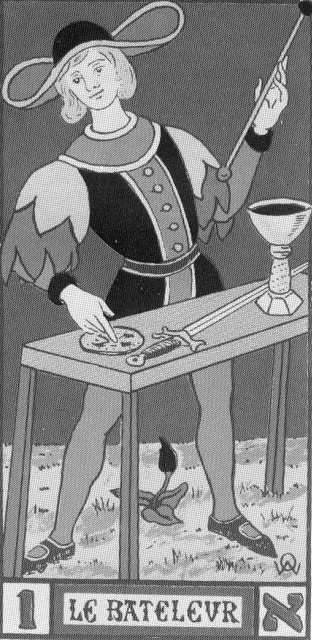 |
Page 18 Spring 1990
|
Tarot Hides Mystery of the Juggling "Batleur"
I
have always been interested in mysticism and metaphysics. Looking
through a book by P.D. Ouspensky, I
found a chapter on Tarot with a detailed description of a card called
'The Juggler." I had never seen the card described this way, and
determined to investigate...
The
earliest known decks of Tarot cards appeared in medieval Europe. One
theory is that they were brought by gypsies - Bohemian mystics
believed to have come from India through Egypt. The cards appeared to
be patterned after ancient Egyptian hieroglyphics.
The
ancient mystics believed that truth was less likely to be obscured if
it was passed on in the form of symbols. Therefore the 78 cards in
Tarot decks contain many symbols and characters. These reflect the
energies and teachings of the Caballa, astrology and numerology, with
various analogies drawn to every other belief system know.
Tarot
is known as a "meditative Yoga of the West." The 22 Trump
cards are meant to depict the stages of evolution. The four suits -
discs, wands, cups and swords - are meant to depict all relative
aspects of consciousness. Through meditation and reflection on the
cards and their interrelations, one can become familiar with all
aspects of consciousness, and how that reflects one's particular
nature.
Then
through an intricate process of understanding, align one's world view
from the personal to the universal and reach enlightenment.
Mystics,
believing man is given to vice, hid the symbols in a deck of cards.
This way the unenlightened may at least have the system of reference
in mind to be able to effectively apply them when the time is ripe.
There
are many different Tarot decks, and of those, each has many different
interpretations. After arduous research I had more trepidation and
questions about our card, the juggler, than before. I needed help.
My
card (the juggler) was most commonly referred to in Tarot as Le
Batleur," the bearer of the wand (energy sent forth). In later
versions of the first known deck, the Visconte Sforza deck, Le Batleur
was known as the Magician or Juggler. He represents in mythological
belief systems the characters of Mercury, Thoth, Loki, Beth and
Wednesday. If he was described by one word, it would be ''will."
Patriarchal belief systems aside, Le Batleur could represent a male or
female.
One
arm points up and one down - as above, so below. This dual sign shows
the descent of grace, virtue and light drawn from things above and
derived from things below.
The
sign of infinity over the head represents life, holy spirit, eternal
spirit, closed world, motion. His person rests in the world of matter.
According to Martinism, the sideways figure eight that represents
infinity is also the number of Christ. About his waist is the serpentcincture, the snake that eats its tail, the symbol of eternity, regeneration, attainment in the spirit. Beneath him are roses and lillies to show the culture of energy and polarity. In the Visconti Sforza Tarot deck, he has placed the other symbols on his altar. In the Alaister Crowley deck he is juggling them. The sword (air) symbolizes the intellect. The cup (water) symbolizes love, emotions, the Holy Grail. The disc (earth) symbolizes matter, property, or business dealings. He is also juggling the papyrus, or word, and the pen, or will. |
 |